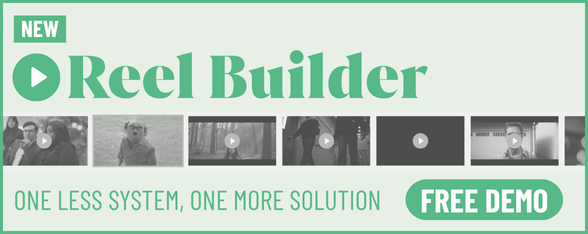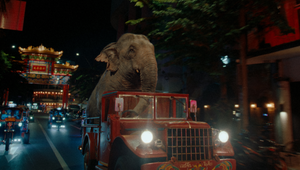
Ed Rosie’s Obsession with Talking to Robots

Ed Rosie has spent over 15 years working at top agencies for a range of global brands, honing his craft as a true production all-rounder.
He began his career in post-production as an editor at Kream – the production arm of Karmarama – before moving into life on set as a commercials director, where he spent the bulk of his career.
In 2016, he co-founded and went on to creatively lead the internal production team at Iris Worldwide. Now, as executive producer at Girl&Bear, Ed focuses on bridging the gap between creative and production – working closely with creative teams in development, producers in production, and post artists in delivery to help bring the best work to life.
LBB> What is your niche craft obsession?
Ed> I’ve got too many obsessions – and most of them are niches within niches.
Seems obvious, but my phone and tablet are invaluable to me when filmmaking. So many apps. So many use cases. I even made an app to help in the process (It’s called Codeck – go check it out).
I thought I could talk about lenses, cameras or maybe something in that world.
But no.
One particular thing I can’t seem to get enough of in recent years is… voice notes.
I find them ridiculously useful for all aspects of planning and doing. Before I adopted the technique I’m about to explain, I used to spend hours overthinking how to kick off a treatment or creative proposal. A truth? An anecdote? A joke – good or bad. I’d then spend a similar amount of time restructuring it and, before I knew it, I’d have a mediocre-sized paragraph or two and the entire day had evaporated in front of my eyes.
Now, I get my phone out, walk around for 10 minutes (often more – I’m a terrible rambler) talking into my phone. I then transcribe it and often ask whatever large language model I’m using to restructure my thoughts – minus the ramble. This whole process gives me one solid page, in my words and tone of voice, that I can then build on. Then I’m into crafting, editing, sculpting – whatever verb you want to use.
LBB> Where / when / how did you first come across this thing?
Ed> Not sure, but I’m going to apportion a bit of blame to my wife, who loves to send voice notes to her friends. I used to think it was a bit ridiculous – then I started doing it and hey, look at me now, I send them to myself.
From a planning perspective, I’d say maybe three to four years ago. Around this time Premiere introduced speech-to-text transcriptions. These days, lots of programs do it in a much simpler way – notably the native voice memos app on iOS – but back then, you had to rely on Premiere or some janky website full of pop-ups to do the transcription for you.
I just found I could talk way more freely than I could type to begin with, and once I discovered this hack, it freed me from the dreaded writer's block that always plagued me at the start.
LBB> Was it an obsession straight away or something that has evolved over the years?
Ed> It’s definitely evolved. And maybe I should take this opportunity to pivot slightly – it’s not just about voice notes, it’s about technology in general. The ability to use a variety of software and tools to accelerate processes. We are seeing that lots right now, especially at G&B where post production in particular are adopting lots of lovely little time and quality hacks using newly available tools and bespoke scripts to accelerate elements of the job.
Obviously, lots of people are using LLMs (large language models), me included, although the prevalence of the em dash – and its association with ChatGPT – has forced me to adopt a friend’s technique of placing a space either side of my em dashes, and occasionally (incorrectly) using hyphens, just so I’m not falsely accused of laziness. I digress.
Anyway, as I mentioned at the start, there are tons of clever apps that can help in planning productions. Much to the frustration of my DOPs, I’m sure – as this is definitely their division – I love Sun Surveyor, Artemis and the Lightroom app. In a nutshell, they tell you where the sun will be in the sky and when. Artemis lets you preview lens types and aspect ratios using your phone and Lightroom is just a great tool for quickly grading or retouching images. These are all great for recces and understanding what’s possible or practical on the particular job you’re working on.
LBB> What are the most interesting debates or conversations you’re having around this obsession?
Ed> I think when I tell people I get my thoughts down using voice notes, they generally look a bit puzzled. Slightly concerned. Then mildly interested. Then they walk away?
LBB> How widespread do you think this obsession is with your peers?
Ed> Not widespread enough! Look, I’m not sure – each to their own, I guess. It’s just one of a few techniques I’ve adopted to accelerate my own process.
A colleague jokes about me talking to robots. But I’d like to think I’ll have the last laugh in 10 years when they’re ruling the world and they remember me as an early adopter.
LBB> Can you share any examples of work where that obsession really came to the fore and elevated the final production? Can you tell us about it and share links if possible?
Ed> A while back, I had the opportunity to direct some work for The National Lottery. The whole job was produced and post-produced from start to finish through Girl&Bear. It was a real team effort – all of the hands, on all of the deck – and I know this gets said a lot, but we genuinely had way less time than we’d usually need. About four weeks from green light to shoot – which was the week before Christmas. Nine TV ads. Three days. Three locations.
It was busy.
I remember being in a meeting on a Wednesday night in November and being asked to pull a treatment together – politely requested for Friday midday. And it needed to be good. Really good.
I remember leaving the office with a fine blend of excitement and immense pressure. I used my little voice note trick to start fleshing out what became a fully blown 32-page treatment.
I got home, carried on writing into the evening, and had broken the back of the words by midday the next day. I don’t like to work that quickly – and it doesn’t happen often – but historically, that would have taken me much longer, and I wouldn’t have slept well knowing what needed to get done.
LBB> For anyone just getting into your field, what advice would you share to help them get their head around this particular thing?
Ed> OK, so, nobody ever really sat me down and told me how to write creatively. Or structure a production proposal. Or pull a treatment together. I totally learned that on the job – and maybe that’s right, maybe it’s not. There are loads of good educational platforms and places where you can learn this more traditionally, I’m sure.
That said, I try to share what I’ve picked up over the years – little shortcuts and ways to speed things up without losing the good stuff. It’s about prioritising craft without compromise – working smarter, but never cutting corners where it counts. Treatments will always be personal, but I hope what I’ve learned can help others shape their own unique approach.
I’ve had a magically varied career to date – a heavy portion of creativity with just the right sprinkling of other stuff – and looking back, nearly everything I’ve learned has come through observation and doing. “Doing the do”, as another good friend used to say. To get good at doing it, you just have to… do it.
But here’s the thing – be true to how you want to do it. There are lots of opinions – many valid and needed – and some that are just noise. You’ve got to try and filter those bits out. At the end of the day, you have to deliver the idea you’ve written. So be true to how you want to do it. And do your very best to deliver on your creative promise.















